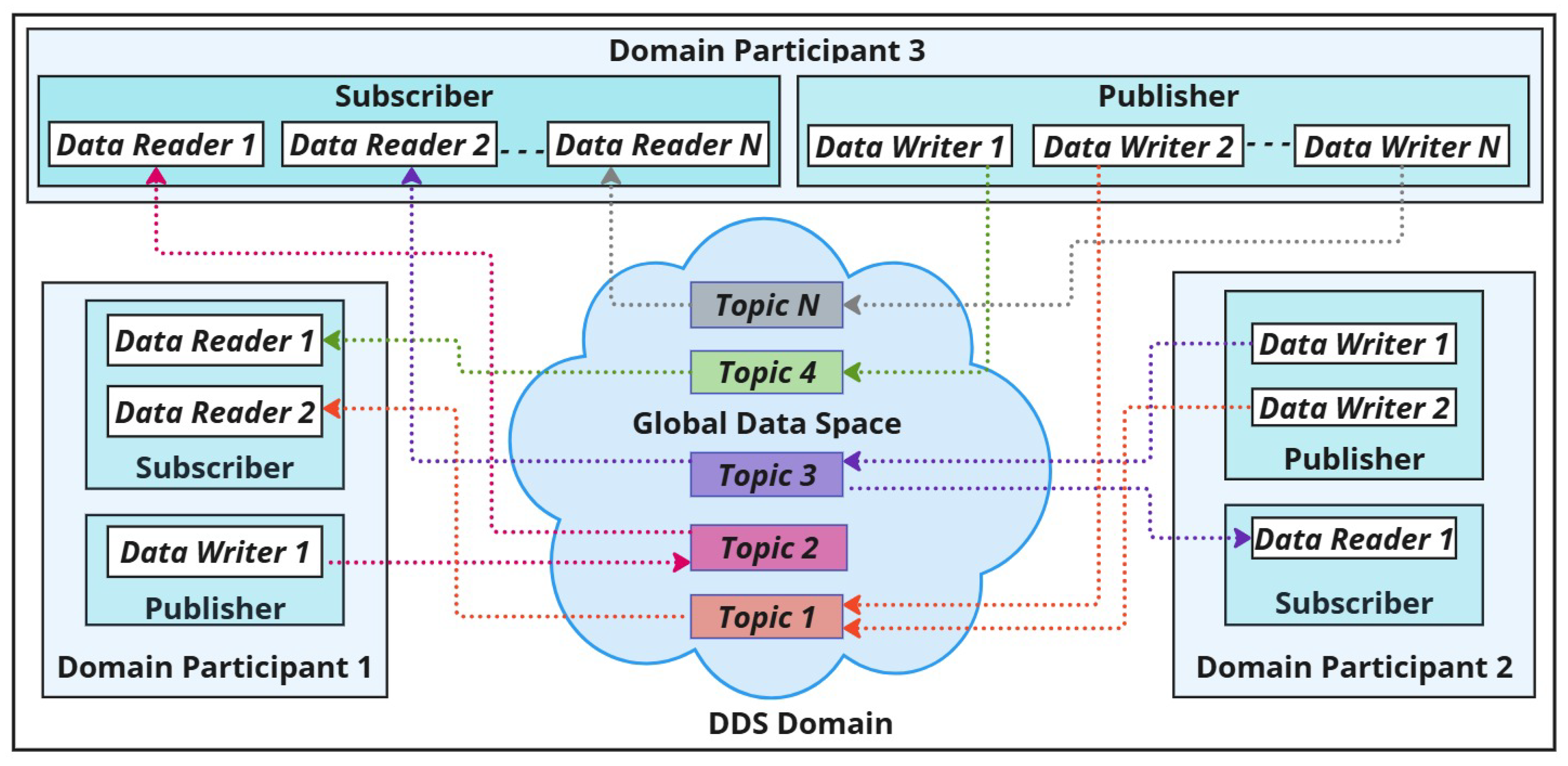A Systematic Literature Review of DDS Middleware in Robotic Systems
Abstract
1. Introduction
Contributions
- We provide an in-depth examination of how DDS middleware enhances communication, interoperability, and coordination in robotic systems, focusing on real-time performance and scalability across diverse application domains.
- We present a structured taxonomy of DDS-based middleware applications in robotics, organizing the literature by communication paradigms, system architectures, and functional domains to support future research and development.
- We investigate key challenges in implementing DDS in robotic systems, including middleware integration, scalability, configuration complexity, and performance bottlenecks in real-time environments.
- We also discuss the security and privacy implications of applying DDS in robotics, highlighting current vulnerabilities and evaluating the tradeoffs in implementing secure communication mechanisms. This topic is addressed separately from key challenges due to the depth and volume of relevant findings in the reviewed literature.
2. Methodology
- RQ1: What are the applications of DDS-based middleware in robotics?
- RQ2: What challenges come with DDS implementation in robotics?
- RQ3: What security and privacy implications does DDS-based middleware have in robotics?
2.1. Information Sources
2.2. Search Strategy
2.3. Screening and Selection Process
2.4. Generative AI Usage
3. Middleware Overview
3.1. Middleware
3.2. Types of Middleware
3.3. Middleware Applications
3.4. Data Distribution Service (DDS) Middleware
3.4.1. Architecture of DDS Middleware
- Domain: This is a logical concept representing a group of applications that can communicate with each other. A DDS system can have multiple domains, each representing different sets of applications that interact with each other and consist of one or more Domain Participants [32].
- Global Data Space (GDS): The GDS in DDS is a core concept that serves as a virtual, fully distributed, and shared space where all data exchanges occur between distributed entities [55]. It allows publishers to write data and subscribers to read it without direct connections, thus decoupling them in time and space [54]. The GDS enables the system to become scalable and eliminates the risk of a single point of failure [58].
- Publisher: The Publisher is the middleware entity responsible for publishing data written by data writers on their topics and pushed to the GDS [59]. A publisher may contain multiple data writers. However, a data writer can write on one particular topic.
- Topic: The Topic facilitates the communication between data readers and writers. It specifies a unique name, a data type, and a set of QoS policies for published or subscribed data [32]. A single topic can be linked to multiple publishers and subscribers and has several instances, each identified by a unique key [46].
- Subscriber: The Subscriber is the middleware entity that receives and consumes published data of interest exchanged in the GDS via its corresponding data reader [43,59]. The relationship between the subscriber and the data reader can be one-to-many. However, the data–reader–topic relationship is one-to-one.
3.4.2. Quality of Service (QoS) in DDS Middleware
3.4.3. Security in DDS Middleware
- Data Integrity: The integrity of transmitted data is verified by digital signatures and Message Authentication Codes (MACs) [57]. This strategy prevents messages from being changed or modified in transit, increasing the trustworthiness of communications.
4. DDS Middleware Applications in Robotics
4.1. DDS-Based Communication Techniques in Robotics
4.1.1. Classification by Network Type
Wireless Sensor Networks (WSNs)
Cloud
Fog Computing
Cloud–Edge–End Fusion
4.1.2. Classification by Communication Model
Publish–Subscribe Model
Request–Reply Model
4.2. Applications of DDS in Robotics
4.2.1. Classification by Application Domain
Manufactory Industry
Military Operations
4.2.2. Classification by System Management
Hardware Management
Data Management
Task Management
Bandwidth Management
4.2.3. Classification by Robotic System Types
Autonomous Robots
Service and Social Robots
Multi-Robot Systems
4.2.4. Classification by DDS Functionalities
Cross-Platform Communication
Syntactic Interoperability
Legacy System Integration
Dynamic Discovery
4.3. DDS Based on System Architecture
4.3.1. Distributed System Architecture
4.3.2. Centralized System Architecture
4.3.3. Decentralized System Architecture
4.3.4. Real-Time Systems
4.3.5. Heterogeneous Systems
5. Challenges of Using DDS in Robotics
5.1. System Performance and Scalability
5.2. Implementation and Complexity
5.3. System Integration and Compatibility
5.4. Robustness
6. Security and Privacy Implications of DDS in Robotics
6.1. Authentication and Authorization
6.2. Data Protection
6.3. System Architecture and Protocols
6.4. Other Security Challenges
7. Conclusions
Author Contributions
Funding
Acknowledgments
Conflicts of Interest
Abbreviations
| AGV | Automated Guided Vehicle |
| API | Application Programming Interface |
| ARP-ROS | Aggregated Robot Processing-Robot Operating System |
| AXIS | Advanced eXtensible Interface-streaming |
| BE | Best Effort |
| BTs | Behavior Trees |
| C2 | Command and Control |
| CA | Certificate Authority |
| CBG-Executor | Callback-Group-Level Executor |
| CCA | Cache-Control Algorithm |
| CEDDP | Computing Environment Dedicated to Data Processing |
| CIA | Confidentiality, Integrity, and Availability |
| CPU | Central Processing Unit |
| DDS | Data Distribution Service |
| DIS | Distributed Interactive Simulation |
| DRE | Distributed Real-Time Embedded |
| DTLS | Datagram Transport Layer Security |
| ECC | Elliptic Curve Cryptography |
| FSACtrl | Frame Sensor Adapter to Control |
| GCS | Ground Control Station |
| HLA | High-Level Architecture |
| HMTs | Hardware-Mapped Topics |
| IEC | International Electrotechnical Commission |
| IoT | Internet of Things |
| IPCs | Industrial Personal Computers |
| M2M | Machine-to-Machine |
| MACs | Message Authentication Codes |
| MAVROS | MAVLink Extending to ROS |
| MMS | Mission Management Station |
| MRS | Multi-Robot System |
| NIEM | National Information Exchange Model |
| OMG | Object Management Group |
| PLCs | Programmable Logic Controllers |
| QoC | Quality of Control |
| QoS | Quality of Service |
| RAS | Robotic Automation System |
| RLbI | Robot Learning by Imitation |
| RMF | Robotics Middleware Framework |
| ROS | Robot Operating System |
| ROS 2 | Robot Operating System 2 |
| RQs | Research Questions |
| RTI | Real-Time Innovation |
| RTOS | Real-Time Operating System |
| RTPS | Real-Time Publish–Subscribe |
| SIRI | Simulated Interactive Robotics Initiative |
| SLAM | Simultaneous Localization and Mapping |
| SLR | Systematic Literature Review |
| SMEs | Small- and Medium-sized Enterprises |
| SO | Soft Real-Time |
| SSL | Secure Sockets Layer |
| SSR | SeoulTech Service Robot |
| TCP | Transmission Control Protocol |
| TLSF | Two-Level Segregated Fit |
| TSN | Time-Sensitive Networking |
| UAVs | Unmanned Aerial Vehicles |
| UDP | User Datagram Protocol |
| UGVs | Unmanned Ground Vehicles |
| XML | Extensible Markup Language |
References
- Koditschek, D.E. What Is Robotics? Why Do We Need It and How Can We Get It? Annu. Rev. Control. Robot. Auton. Syst. 2021, 4, 1–33. [Google Scholar] [CrossRef]
- Siciliano, B.; Khatib, O. (Eds.) Springer Handbook of Robotics; Springer Handbooks; Springer International Publishing: Cham, Switzerland, 2016. [Google Scholar] [CrossRef]
- Craig, J.J. Introduction to Robotics: Mechanics and Control, 3rd ed.; Pearson Prentice Hall: Upper Saddle River, NJ, USA, 2005. [Google Scholar]
- Bekey, G.A. Autonomous Robots: From Biological Inspiration to Implementation and Control; MIT Press: Cambridge, MA, USA, 2005. [Google Scholar]
- Garcia, E.; Jimenez, M.A.; Santos, P.G.D.; Armada, M. The evolution of robotics research. IEEE Robot. Autom. Mag. 2007, 14, 90–103. [Google Scholar] [CrossRef]
- Ben-Ari, M.; Mondada, F. Robots and Their Applications; Springer International Publishing: Cham, Switzerland, 2018; pp. 1–20. [Google Scholar] [CrossRef]
- Baumann, C.; Martinoli, A. A modular functional framework for the design and evaluation of multi-robot navigation. Robot. Auton. Syst. 2021, 144, 103849. [Google Scholar] [CrossRef]
- Selcuk, A.A. A Guide for Systematic Reviews: PRISMA. Turk. Arch. Otorhinolaryngol. 2019, 57, 57–58. [Google Scholar] [CrossRef]
- Rathi, N.; Bandavade, P.; Chaubey, H.; Jaju, S.; Thakur, S. Comprehensive Study of Advantages, Limitations, Applications and Similar Tool of ChatGPT. In Proceedings of the 2024 International Conference on Artificial Intelligence and Quantum Computation-Based Sensor Application (ICAIQSA), Nagpur, India, 20–21 December 2024; pp. 1–4. [Google Scholar] [CrossRef]
- Fitria, T.N. Grammarly as AI-powered English writing assistant: Students’ alternative for writing English. Metathesis J. Engl. Lang. Lit. Teach. 2021, 5, 65–78. [Google Scholar] [CrossRef]
- Bishop, T.A.; Karne, R.K. A survey of middleware. In Proceedings of the CATA, Honolulu, HI, USA, 26–28 March 2003; pp. 254–258. [Google Scholar]
- Almadani, B.; Alissa, S.; Alshareef, R.; Aliyu, F.; Al-Nahari, E. A Survey of Middleware Adoption in Nonprofit Sectors: A Sustainable Development Perspective. Sustainability 2024, 16, 8904. [Google Scholar] [CrossRef]
- Sadok, D.F.H.; Gomes, L.L.; Eisenhauer, M.; Kelner, J. A middleware for industry. Comput. Ind. 2015, 71, 58–76. [Google Scholar] [CrossRef]
- Susnjara, S.; Smalley, I. What Is Middleware? 2024. Available online: https://www.ibm.com/think/topics/middleware (accessed on 27 November 2024).
- Vinoski, S. Where is middleware. IEEE Internet Comput. 2002, 6, 83–85. [Google Scholar] [CrossRef]
- Jiang, Y.; Liu, Q.; Qin, C.; Su, J.; Liu, Q. Message-oriented Middleware: A Review. In Proceedings of the 2019 5th International Conference on Big Data Computing and Communications (BIGCOM), Qingdao, China, 9–11 August 2019; pp. 88–97. [Google Scholar] [CrossRef]
- Abraham, B.; Aguilar, J.; Leiss, E. Middleware for Improving Security in a Component Based Software Architecture. Netw. Comput. Adv. Inf. Manag. 2008, 1, 502–509. [Google Scholar] [CrossRef]
- Cahill, V. Building a dynamically reconfigurable minimum CORBA platform with components, connectors and language-level support. In Proceedings of the Middleware 2000 Workshop on Reflective Middleware (RM 2000), New York, NY, USA, 7–8 April 2000; pp. 1–2. [Google Scholar]
- Qureshi, N.A.; Perini, A. An Agent-Based Middleware for Adaptive Systems. In Proceedings of the Eighth International Conference on Quality Software, Oxford, UK, 12–13 August 2008; pp. 423–428. [Google Scholar] [CrossRef]
- Hapner, M.; Burridge, R.; Sharma, R.; Fialli, J.; Stout, K. Java Message Service; Sun Microsystems Inc.: Santa Clara, CA, USA, 2002; Volume 9, Available online: https://raw.githubusercontent.com/TIM168/technical_books/master/Java/JMS20.pdf (accessed on 27 November 2024).
- Mackey, A. Windows Communication Foundation. In Introducing.NET 4.0: With Visual Studio 2010; Apress: Berkeley, CA, USA, 2010; pp. 159–173. [Google Scholar] [CrossRef]
- RTI. Connext Product Suite for Intelligent Distributed Systems. 2025. Available online: https://www.rti.com/products (accessed on 24 February 2025).
- eProsima. eProsima Fast DDS Documentation—Fast DDS 3.1.2 Documentation. 2025. Available online: https://fast-dds.docs.eprosima.com/ (accessed on 24 February 2025).
- OMG. OMG Data Distribution Service (DDS) Version 1.4. 2015. Available online: http://www.omg.org/spec/DDS/1.4 (accessed on 27 November 2024).
- Newton-King, J.; Latham, L.; Pickett, W.; Anderson, R. Why Migrate WCF to asp.net Core grpc—Microsoft Learn. 2024. Available online: https://bit.ly/3CLlwFb (accessed on 27 November 2024).
- Boonma, P.; Suzuki, J. TinyDDS: An interoperable and configurable publish/subscribe middleware for wireless sensor networks. In Wireless Technologies: Concepts, Methodologies, Tools and Applications; IGI Global: Hershey, PA, USA, 2012; pp. 819–846. [Google Scholar]
- Almadani, B.; Saeed, B.; Alroubaiy, A. Healthcare systems integration using Real Time Publish Subscribe (RTPS) middleware. Comput. Electr. Eng. 2016, 50, 67–78. [Google Scholar] [CrossRef]
- Fersi, G. Study of Middleware for Internet of Healthcare Things and Their Applications. Impact Digit. Technol. Public Health Dev. Dev. Ctries. 2020, 12157, 223–231. [Google Scholar]
- Ahn, M.K.; Park, Y.W.; Jee, T.Y. Component based open middleware architecture for autonomous navigation system. In Proceedings of the Unmanned Systems Technology IX, SPIE, Orlando, FL, USA, May 2007; pp. 653–660. [Google Scholar] [CrossRef]
- Mohamed, N.; Al-Jaroodi, J.; Jawhar, I.; Lazarova-Molnar, S. Middleware requirements for collaborative unmanned aerial vehicles. In Proceedings of the 2013 International Conference on Unmanned Aircraft Systems (ICUAS), Atlanta, GA, USA, 28–31 May 2013; pp. 1051–1060. [Google Scholar] [CrossRef]
- Bode, V.; Trinitis, C.; Schulz, M.; Buettner, D.; Preclik, T. DDS Implementations as Real-Time Middleware—A Systematic Evaluation. In Proceedings of the 2023 IEEE 29th International Conference on Embedded and Real-Time Computing Systems and Applications (RTCSA), Niigata, Japan, 30 August–1 September 2023; pp. 186–195. [Google Scholar] [CrossRef]
- Köksal, Ö.; Tekinerdogan, B. Obstacles in Data Distribution Service Middleware: A Systematic Review. Future Gener. Comput. Syst. 2017, 68, 191–210. [Google Scholar] [CrossRef]
- Palade, A.; Cabrera, C.; Li, F.; White, G.; Razzaque, M.A.; Clarke, S. Middleware for Internet of Things: An evaluation in a small-scale IoT environment. J. Reliab. Intell. Environ. 2018, 4, 3–23. [Google Scholar] [CrossRef]
- Choi, H.Y.; King, A.L.; Lee, I. Making DDS really real-time with OpenFlow. In Proceedings of the 2016 International Conference on Embedded Software (EMSOFT), Pittsburgh, PA, USA, 2–7 October 2016; pp. 1–10. [Google Scholar] [CrossRef]
- Profanter, S.; Tekat, A.; Dorofeev, K.; Rickert, M.; Knoll, A. OPC UA versus ROS, DDS, and MQTT: Performance Evaluation of Industry 4.0 Protocols. In Proceedings of the 2019 IEEE International Conference on Industrial Technology (ICIT), Pittsburgh, PA, USA, 1–7 October 2016; pp. 955–962. [Google Scholar] [CrossRef]
- Appius, A.X.; Bauer, E.; Blöchlinger, M.; Kalra, A.; Oberson, R.; Raayatsanati, A.; Strauch, P.; Suresh, S.; von Salis, M.; Katzschmann, R.K. RAPTOR: Rapid Aerial Pickup and Transport of Objects by Robots. In Proceedings of the 2022 IEEE/RSJ International Conference on Intelligent Robots and Systems (IROS), Kyoto, Japan, 23–27 October 2022; pp. 349–355. [Google Scholar] [CrossRef]
- RTI. RTI Connext DDS. 2024. Available online: https://www.rti.com/ (accessed on 24 February 2025).
- Object Computing. OpenDDS. 2025. Available online: https://opendds.org/ (accessed on 24 February 2025).
- Twin Oaks Computing. CoreDX DDS Data Distribution Service Middleware | Twin Oaks Computing, Inc. 2020. Available online: https://www.twinoakscomputing.com/coredx/ (accessed on 24 February 2025).
- ADLINK Technology. Vortex OpenSplice. 2021. Available online: https://www.adlinktech.com/en/vortex-opensplice-data-distribution-service (accessed on 24 February 2025).
- GurumNetworks. GurumDDS. 2025. Available online: https://www.gurum.cc/gurumdds_eng (accessed on 24 February 2025).
- Eclipse Incubation. Eclipse Cyclone DDS—Home. 2024. Available online: https://cyclonedds.io/ (accessed on 24 February 2025).
- Kim, H.; Kim, D.K.; Alaerjan, A. ABAC-Based Security Model for DDS. IEEE Trans. Dependable Secur. Comput. 2022, 19, 3113–3124. [Google Scholar] [CrossRef]
- Nwadiugwu, W.; Kim, D.; Ejaz, W.; Anpalagan, A. MAD-DDS: Memory-efficient automatic discovery data distribution service for large-scale distributed control network. IET Commun. 2023, 17, 1432–1446. [Google Scholar] [CrossRef]
- Song, B.; Hu, X.; Xiao, J.; Zhang, G.; Wang, S.; Zhou, Q. Integration of Data Distribution Service into Partitioned Real-time Embedded Systems. In Proceedings of the 2020 15th IEEE Conference on Industrial Electronics and Applications (ICIEA), Virtual Event, 9–13 November 2020; pp. 1606–1611. [Google Scholar] [CrossRef]
- Alaerjan, A.; Kim, D.K.; Ming, H.; Kim, H. Configurable DDS as Uniform Middleware for Data Communication in Smart Grids. Energies 2020, 13, 1839. [Google Scholar] [CrossRef]
- Wen, J.; Jiang, L.; Zhu, J.; Qiu, Z.; Chu, C.C. Design of Data Distributed Service-Based Distributed Co-Simulation Platform of Power Systems. In Proceedings of the 2023 IEEE Industry Applications Society Annual Meeting (IAS), Nashville, TN, USA, 29 October–2 November 2023; pp. 1–7. [Google Scholar] [CrossRef]
- Zhang, J.; Yu, X.; Sier, H.; Queralta, J.P.; Westerlund, T. Comparison of DDS, MQTT, and Zenoh in Edge-to-Edge and Edge-to-Cloud Communication for Distributed ROS 2 Systems. arXiv 2023, arXiv:2309.07496. Available online: https://api.semanticscholar.org/CorpusID:261823232 (accessed on 27 November 2024).
- Du, J.; Gao, C.; Feng, T. Formal Safety Assessment and Improvement of DDS Protocol for Industrial Data Distribution Service. Future Internet 2023, 15, 24. [Google Scholar] [CrossRef]
- Alaerjan, A.; Kim, D.K. Adopting DDS to Smart Grids: Towards Reliable Data Communication. In Smart Cities, Green Technologies, and Intelligent Transport Systems; Helfert, M., Klein, C., Donnellan, B., Gusikhin, O., Eds.; Springer: Cham, Switzerland, 2017; pp. 154–169. [Google Scholar]
- RFWW. DDS Protocol Architecture Basics: DDS Protocol in IoT. 2024. Available online: https://www.rfwireless-world.com/Terminology/DDS-protocol-architecture.html (accessed on 1 March 2025).
- ADLINK Technology. Using DDS for Scalable, High Performance, Real-time Data Sharing in Next Generation Modeling & Simulation Systems; Whitepaper; ADLINK Technology Inc.: Taoyuan, Taiwan, 2019. [Google Scholar]
- DDSF. What’s in the DDS Standard? 2024. Available online: https://www.dds-foundation.org/omg-dds-standard/ (accessed on 1 March 2025).
- Bellavista, P.; Corradi, A.; Foschini, L.; Pernafini, A. Data Distribution Service (DDS): A performance comparison of OpenSplice and RTI implementations. In Proceedings of the 2013 IEEE Symposium on Computers and Communications (ISCC), Split, Croatia, 7–10 July 2013; pp. 377–383. [Google Scholar] [CrossRef]
- Zhang, X.; Zhang, X.; Wang, S.; Xiao, P. Design and Implementation of Robot Middleware Service Integration Framework Based on DDS. In Proceedings of the 2022 IEEE International Conference on Real-time Computing and Robotics (RCAR), Guiyang, China, 17–22 July 2022; pp. 588–593. [Google Scholar] [CrossRef]
- OMG. The Real-Time Publish-Subscribe Protocol DDS Interoperability Wire Protocol (DDSI-RTPSTM) Specification. 2022. Available online: https://www.omg.org/spec/DDSI-RTPS/2.5/PDF (accessed on 1 March 2025).
- Object Management Group (OMG). DDS Security Specification Version 1.1. 2024. Available online: https://www.omg.org/spec/DDS-SECURITY (accessed on 27 November 2024).
- Yang, Y.; Azumi, T. Exploring Real-Time Executor on ROS 2. In Proceedings of the 2020 IEEE International Conference on Embedded Software and Systems (ICESS), Shanghai, China, 10–11 December 2020; pp. 1–8. [Google Scholar] [CrossRef]
- Al-hammouri, M.; Madani, B.; Aloqaily, M.; Ridhawi, I.A.; Jararweh, Y. Scalable Video Streaming for Real-Time Multimedia Applications over DDS Middleware for Future Internet Architecture. In Proceedings of the 2018 IEEE/ACS 15th International Conference on Computer Systems and Applications (AICCSA), Aqaba, Jordan, 28 October–1 November 2018; pp. 1–6. [Google Scholar] [CrossRef]
- Inglús-Romero, J.F.; Romero-Garcés, A.; Vicente-Chicote, C.; Martínez, J. A Model-Driven Approach to Enable Adaptive QoS in DDS-Based Middleware. IEEE Trans. Emerg. Top. Comput. Intell. 2017, 1, 176–187. [Google Scholar] [CrossRef]
- Essers, M.; Vaneker, T. Evaluating a Prototype Approach to Validating a DDS-based System Architecture for Automated Manufacturing Environments. Procedia CIRP 2014, 25, 385–392. [Google Scholar] [CrossRef][Green Version]
- White, T.; Johnstone, M.N.; Peacock, M. An investigation into some security issues in the DDS messaging protocol. In Proceedings of the 15th Australian Information Security Management Conference, Perth, Australia, 5–6 December 2017. [Google Scholar]
- Beckman, K.; Reininger, J. Adaptation of the DDS Security Standard for Resource-Constrained Sensor Networks. In Proceedings of the 2018 IEEE 13th International Symposium on Industrial Embedded Systems (SIES), Graz, Austria, 6–8 June 2018; pp. 1–4. [Google Scholar] [CrossRef]
- Wagner, P.G.; Birnstill, P.; Beyerer, J. DDS Security+: Enhancing the Data Distribution Service With TPM-based Remote Attestation. In Proceedings of the 19th International Conference on Availability, Reliability and Security—ARES ’24, Vienna, Austria, 30 July–2 August 2024. [Google Scholar] [CrossRef]
- Han, J.H. Message encryption methods for DDS security performance improvement. J. Korea Inst. Inf. Commun. Eng. 2018, 22, 1554–1561. [Google Scholar]
- Friesen, M.; Karthikeyan, G.; Heiss, S.; Wisniewski, L.; Trsek, H. A comparative evaluation of security mechanisms in DDS, TLS and DTLS. In Kommunikation und Bildverarbeitung in der Automation; Springer: Berlin/Heidelberg, Germany, 2020; pp. 201–216. [Google Scholar]
- Luo, Q.; Shi, R. A Decentralized Access Control Framework For DDS. In Proceedings of the 2021 IEEE Sixth International Conference on Data Science in Cyberspace (DSC), Shenzhen, China, 9–11 October 2021; pp. 211–218. [Google Scholar] [CrossRef]
- Fernandez, J.; Allen, B.; Thulasiraman, P.; Bingham, B. Performance Study of the Robot Operating System 2 with QoS and Cyber Security Settings. In Proceedings of the 2020 IEEE International Systems Conference (SysCon), Montreal, QC, Canada, 20–23 April 2020; pp. 1–6. [Google Scholar] [CrossRef]
- Mamani-Saico, A.; Yanyachi, P.R. Implementation and Performance Study of the Micro-ROS/ROS2 Framework to Algorithm Design for Attitude Determination and Control System. IEEE Access 2023, 11, 128451–128460. [Google Scholar] [CrossRef]
- Calvo, I.; Pérez, F.; Etxeberria-Agiriano, I.; de Albéniz, O.G. Designing High Performance Factory Automation Applications on Top of DDS. Int. J. Adv. Robot. Syst. 2013, 10, 205. [Google Scholar] [CrossRef]
- Aliyu, F.; Umar, S.; Al-Duwaish, H. A Survey of Applications of Artificial Neural Networks in Wireless Sensor Networks. In Proceedings of the 2019 8th International Conference on Modeling Simulation and Applied Optimization (ICMSAO), Manama, Bahrain, 15–17 April 2019; pp. 1–5. [Google Scholar] [CrossRef]
- Jeong, S.; Ga, T.; Jeong, I.; Choi, J. Behavior tree driven multi-mobile robots via data distribution service (DDS). In Proceedings of the 2021 21st International Conference on Control, Automation and Systems (ICCAS), Jeju, Korea, 12–15 October 2021; pp. 1633–1638. [Google Scholar]
- Iovino, M.; Scukins, E.; Styrud, J.; Ögren, P.; Smith, C. A survey of Behavior Trees in robotics and AI. Robot. Auton. Syst. 2022, 154, 104096. [Google Scholar] [CrossRef]
- Hartanto, R.; Eich, M. Reliable, cloud-based communication for multi-robot systems. In Proceedings of the 2014 IEEE International Conference on Technologies for Practical Robot Applications (TePRA), Woburn, WA, USA, 14–15 April 2014; pp. 1–8. [Google Scholar] [CrossRef]
- Stojmenovic, I.; Wen, S.; Huang, X.; Luan, H. An overview of fog computing and its security issues. Concurr. Comput. Pract. Exp. 2016, 28, 2991–3005. [Google Scholar] [CrossRef]
- Das, R.; Inuwa, M.M. A review on fog computing: Issues, characteristics, challenges, and potential applications. Telemat. Inform. Rep. 2023, 10, 100049. [Google Scholar] [CrossRef]
- Parmar, N.; Ranga, V.; Simhachalam Naidu, B. Syntactic Interoperability in Real-Time Systems, ROS 2, and Adaptive AUTOSAR Using Data Distribution Services: An Approach. In Inventive Communication and Computational Technologies; Springer: Singapore, 2020; pp. 257–274. [Google Scholar] [CrossRef]
- Ichnowski, J.; Chen, K.; Dharmarajan, K.; Adebola, S.; Danielczuk, M.; Mayoral-Vilches, V.; Jha, N.; Zhan, H.; Llontop, E.; Xu, D.; et al. FogROS2: An Adaptive Platform for Cloud and Fog Robotics Using ROS 2. In Proceedings of the 2023 IEEE International Conference on Robotics and Automation (ICRA), London, UK, 29 May–2 June 2023; pp. 5493–5500. [Google Scholar] [CrossRef]
- Chen, K.; Hoque, R.; Dharmarajan, K.; LLontopl, E.; Adebola, S.; Ichnowski, J.; Kubiatowicz, J.; Goldberg, K. FogROS2-SGC: A ROS2 Cloud Robotics Platform for Secure Global Connectivity. In Proceedings of the 2023 IEEE/RSJ International Conference on Intelligent Robots and Systems (IROS), Detroit, MI, USA, 1–5 October 2023; pp. 1–8. [Google Scholar]
- Ismahil, D. Investigating Fog-and Cloud-Based Control Loops for Future Smart Factories. Bachelor’s Thesis, Mälardalen University, Västerås, Sweden, 2017. [Google Scholar]
- Lu, Y.; Yang, L.; Yang, S.X.; Hua, Q.; Sangaiah, A.K.; Guo, T.; Yu, K. An intelligent deterministic scheduling method for ultralow latency communication in edge enabled industrial Internet of Things. IEEE Trans. Ind. Inform. 2022, 19, 1756–1767. [Google Scholar] [CrossRef]
- Benomar, Z.; Campobello, G.; Segreto, A.; Battaglia, F.; Longo, F.; Merlino, G.; Puliafito, A. A fog-based architecture for latency-sensitive monitoring applications in industrial internet of things. IEEE Internet Things J. 2021, 10, 1908–1918. [Google Scholar] [CrossRef]
- Ji, C.H.; Hu, C.Y.; Liu, Z.D.; Ding, N. A Time-Sensitive Attribute-Oriented Multi-Message Dynamic Scheduling Method in ROS2-RTPS. In Proceedings of the 2023 IEEE International Conference on Smart Internet of Things (SmartIoT), Xining, China, 25–27 August 2023; pp. 211–217. [Google Scholar] [CrossRef]
- RTI. The Request-Reply Pattern. 2025. Available online: https://bit.ly/3DrPRsB (accessed on 3 March 2025).
- Lienen, C.; Middeke, S.H.; Platzner, M. FPGADDS: An Intra-FPGA Data Distribution Service for ROS 2 Robotics Applications. In Proceedings of the 2023 IEEE/RSJ International Conference on Intelligent Robots and Systems (IROS), Detroit, MI, USA, 1–5 October 2023; pp. 6261–6266. [Google Scholar] [CrossRef]
- Zutell, J.M.; Conner, D.C.; Schillinger, P. ROS 2-Based Flexible Behavior Engine for Flexible Navigation. In Proceedings of the SoutheastCon 2022, Mobile, AL, USA, 26 March–3 April 2022; pp. 674–681. [Google Scholar] [CrossRef]
- Kampmann, A.; Wüstenberg, A.; Alrifaee, B.; Kowalewski, S. A Portable Implementation of the Real-Time Publish-Subscribe Protocol for Microcontrollers in Distributed Robotic Applications. In Proceedings of the 2019 IEEE Intelligent Transportation Systems Conference (ITSC), Auckland, New Zealand, 27–30 October 2019; pp. 443–448. [Google Scholar] [CrossRef]
- Poza-Luján, J.L.; Posadas-Yagüe, J.L.; Simo, J. Relationship between Quality of Control and Quality of Service in Mobile Robot Navigation. Int. J. Imaging Robot. 2014, 12, 90–105. [Google Scholar] [CrossRef]
- Teper, H.; Betz, T.; Günzel, M.; Ebner, D.; Von Der Brüggen, G.; Betz, J.; Chen, J.J. End-To-End Timing Analysis and Optimization of Multi-Executor ROS 2 Systems. In Proceedings of the 2024 IEEE 30th Real-Time and Embedded Technology and Applications Symposium (RTAS), Hong Kong, 13–16 May 2024; pp. 212–224. [Google Scholar] [CrossRef]
- Fedi, F.; Nasca, F. Interoperability Issues Reduction in Command and Control for Multi-robot Systems. In Modelling and Simulation for Autonomous Systems, Proceedings of the Second International Workshop, MESAS 2015, Prague, Czech Republic, 29–30 April 2015; Hodicky, J., Ed.; Springer: Cham, Switzerland, 2015; pp. 77–89. [Google Scholar] [CrossRef]
- Gamboa-Montero, J.J.; Alonso-Martin, F.; Marques-Villarroya, S.; Sequeira, J.; Salichs, M.A. Asynchronous federated learning system for human–robot touch interaction. Expert Syst. Appl. 2023, 211, 118510. [Google Scholar] [CrossRef]
- Sundarapandian, S.; Kim, J.H.; Ferris-Francis, S.; Miller, J.; Prabakar, N.; Charters, C.; Michko, H. A Novel Communication Architecture and Control System for TeleBot: A Multi-Modal Telepresence Robot for Disabled Officers. Int. J. Next Gener. Comput. 2016, 7, 1–18. Available online: https://bit.ly/3StgL7j (accessed on 27 November 2024).
- Criollo, L.; Mena-Arciniega, C.; Xing, S. Classification, military applications, and opportunities of unmanned aerial vehicles. Aviation 2024, 28, 115–127. [Google Scholar] [CrossRef]
- Sandoval, S.; Thulasiraman, P. Cyber Security Assessment of the Robot Operating System 2 for Aerial Networks. In Proceedings of the 2019 IEEE International Systems Conference (SysCon), Orlando, FL, USA, 8–11 April 2019; pp. 1–8. [Google Scholar]
- Phueakthong, P.; Varagul, J. A Development of Mobile Robot Based on ROS2 for Navigation Application. In Proceedings of the 2021 International Electronics Symposium (IES), Surabaya, Indonesia, 29–30 September 2021; pp. 517–520. [Google Scholar] [CrossRef]
- Jalil, A.; Kobayashi, J. Experimental Analyses of an Efficient Aggregated Robot Processing with Cache-Control for Multi-Robot System. In Proceedings of the 2020 20th International Conference on Control, Automation and Systems (ICCAS), Busan-City, Republic of Korea, 13–16 October 2020; pp. 1105–1109. [Google Scholar] [CrossRef]
- Yoo, T.; Choi, B.W. Interactive Path Editing and Simulation System for Motion Planning and Control of a Collaborative Robot. Electronics 2024, 13, 2857. [Google Scholar] [CrossRef]
- Lourenço, L.L.; Oliveira, G.; Méa Plentz, P.D.; Röning, J. Achieving reliable communication between Kafka and ROS through bridge codes. In Proceedings of the 2021 20th International Conference on Advanced Robotics (ICAR), Virtual Event, 6–10 December 2021; pp. 324–329. [Google Scholar] [CrossRef]
- Pradeep, V.; Abhi, B.C.; Abhilash, C.M.; Abhishek, M.S.; Adarsh. Robotics and Automation. Int. J. Adv. Res. Sci. Commun. Technol. (IJARSCT) 2024, 4, 129–134. [Google Scholar] [CrossRef]
- Gutsche, K.; Genovese, J.; Serstjuk, P.; Altindis, S. User-centered design of professional social service robots. In Proceedings of the Intelligent Human Systems Integration (IHSI 2025): Integrating People and Intelligent Systems, Roma, Italy, 24–26 February 2025; Volume 160. [Google Scholar]
- Hung, P.C.K.; Iqbal, F.; Aleem, S.; Rafferty, L. Snapshot of Research Issues in Service Robots. In Service-Oriented Computing—ICSOC 2021 Workshops, Proceedings of the AIOps, STRAPS, AI-PA and Satellite Events, Dubai, United Arab Emirates, 22–25 November 2021; Hacid, H., Aldwairi, M., Bouadjenek, M.R., Petrocchi, M., Faci, N., Outay, F., Beheshti, A., Thamsen, L., Dong, H., Eds.; Springer: Cham, Switzerland, 2022; pp. 363–376. [Google Scholar]
- Jo, Y.H.; Cho, S.; Choi, B.W. Towards a ROS2-based software architecture for service robots. Bull. Electr. Eng. Inform. 2023, 12, 3027–3038. [Google Scholar] [CrossRef]
- Cruz, J.M.; Romero-Garcés, A.; Rubio, J.P.B.; Robles, R.M.; Rubio, A.B. A DDS-based middleware for quality-of-service and high-performance networked robotics. Concurr. Comput. Pract. Exp. 2012, 24, 1761–1776. [Google Scholar] [CrossRef]
- Darmanin, R.N.; Bugeja, M.K. A review on multi-robot systems categorised by application domain. In Proceedings of the 2017 25th Mediterranean Conference on Control and Automation (MED), Valletta, Malta, 3–6 July 2017; pp. 701–706. [Google Scholar] [CrossRef]
- Deshpande, M.; Kamalanathan, N. Behavioral Analysis of ROS motion planners integrated with Robotics Middleware Framework (RMF). In Proceedings of the 2022 IEEE 4th International Conference on Cybernetics, Cognition and Machine Learning Applications (ICCCMLA), Goa, India, 8–9 October 2022; pp. 196–199. [Google Scholar] [CrossRef]
- Fox, D.; Burgard, W.; Thrun, S. The dynamic window approach to collision avoidance. IEEE Robot. Autom. Mag. 1997, 4, 23–33. [Google Scholar] [CrossRef]
- Rösmann, C.; Hoffmann, F.; Bertram, T. Integrated online trajectory planning and optimization in distinctive topologies. Robot. Auton. Syst. 2017, 88, 142–153. [Google Scholar] [CrossRef]
- Macenski, S.; Singh, S.; Martín, F.; Ginés, J. Regulated pure pursuit for robot path tracking. Auton. Robot. 2023, 47, 685–694. [Google Scholar] [CrossRef]
- Dey, E.; Walczak, M.; Anwar, M.S.; Roy, N.; Freeman, J.; Gregory, T.; Suri, N.; Busart, C. A Novel ROS2 QoS Policy-Enabled Synchronizing Middleware for Co-Simulation of Heterogeneous Multi-Robot Systems. In Proceedings of the 2023 32nd International Conference on Computer Communications and Networks (ICCCN), Honolulu, HI, USA, 24–26 July 2023; pp. 1–10. [Google Scholar] [CrossRef]
- Aartsen, M.; Banga, K.; Talko, K.; Touw, D.; Wisman, B.; Meïnsma, D.; Björkqvist, M. Analyzing Interoperability and Security Overhead of ROS2 DDS Middleware. In Proceedings of the 2022 30th Mediterranean Conference on Control and Automation (MED), Athens, Greece, 28 June–1 July 2022; pp. 976–981. [Google Scholar] [CrossRef]
- Open-Rmf. Open-RMF/free_fleet: A Free Fleet Management System. 2024. Available online: https://github.com/open-rmf/free_fleet (accessed on 5 March 2024).
- Pramukantoro, E.S.; Anwari, H. An Event-based Middleware for Syntactical Interoperability in Internet of Things. Int. J. Electr. Comput. Eng. 2018, 8, 3784–3792. [Google Scholar] [CrossRef]
- Jeong, S.; Ga, T.; Jeong, I.; Choi, J. Behavior Tree-Based Task Planning for Multiple Mobile Robots using a Data Distribution Service. In Proceedings of the 2022 IEEE/ASME International Conference on Advanced Intelligent Mechatronics (AIM), Hokkaido, Japan, 11–15 July 2022; pp. 1791–1798. [Google Scholar] [CrossRef]
- Leung, K.Y.K.; Barfoot, T.D.; Liu, H.H.T. Distributed and decentralized cooperative simultaneous localization and mapping for dynamic and sparse robot networks. In Proceedings of the 2011 IEEE International Conference on Robotics and Automation, Shanghai, China, 9–13 May 2011; pp. 3841–3847. [Google Scholar] [CrossRef]
- Kronauer, T.; Pohlmann, J.; Matthé, M.; Smejkal, T.; Fettweis, G. Latency Analysis of ROS2 Multi-Node Systems. In Proceedings of the 2021 IEEE International Conference on Multisensor Fusion and Integration for Intelligent Systems (MFI), Karlsruhe, Germany, 23–25 September 2021; pp. 1–7. [Google Scholar] [CrossRef]
- Essers, M.; Vaneker, T. Evaluating a Data Distribution Service System for Dynamic Manufacturing Environments: A Case Study. Procedia Technol. 2014, 15, 621–630. [Google Scholar] [CrossRef]
- Steve Cardenas, I.; Kumar Paladugula, P.; Kim, J.H. Large Scale Distributed Data Processing for a Network of Humanoid Telepresence Robots. In Proceedings of the 2020 IEEE International IOT, Electronics and Mechatronics Conference (IEMTRONICS), Vancouver, BC, Canada, 9–12 September 2020; pp. 1–9. [Google Scholar] [CrossRef]
- Park, J.; Delgado, R.; Choi, B.W. Real-Time Characteristics of ROS 2.0 in Multiagent Robot Systems: An Empirical Study. IEEE Access 2020, 8, 154637–154651. [Google Scholar] [CrossRef]
- Calisi, D.; Fedi, F.; Leo, A.; Nardi, D. Software Development for Networked Robot Systems. IFAC Proc. Vol. 2010, 43, 605–610. [Google Scholar] [CrossRef]
- Maruyama, Y.; Kato, S.; Azumi, T. Exploring the performance of ROS2. In Proceedings of the 2016 International Conference on Embedded Software (EMSOFT), Pittsburgh, PA, USA, 2–7 October 2016; pp. 1–10. [Google Scholar] [CrossRef]
- Puck, L.; Keller, P.; Schnell, T.; Plasberg, C.; Tanev, A.; Heppner, G.; Roennau, A.; Dillmann, R. Performance Evaluation of Real-Time ROS2 Robotic Control in a Time-Synchronized Distributed Network. In Proceedings of the 2021 IEEE 17th International Conference on Automation Science and Engineering (CASE), Lyon, France, 23–27 August 2021; pp. 1670–1676. [Google Scholar] [CrossRef]
- Deng, G.; Xu, G.; Zhou, Y.; Zhang, T.; Liu, Y. On the (In)Security of Secure ROS2. In Proceedings of the 2022 ACM SIGSAC Conference on Computer and Communications Security, Los Angeles, CA, USA, 7–11 November 2022. [Google Scholar]
- Morita, R.; Matsubara, K. Dynamic Binding a Proper DDS Implementation for Optimizing Inter-Node Communication in ROS2. In Proceedings of the 2018 IEEE 24th International Conference on Embedded and Real-Time Computing Systems and Applications (RTCSA), Hakodate, Japan, 29–31 August 2018; pp. 246–247. [Google Scholar] [CrossRef]
- Sanderson, D.; Shires, E.; Chaplin, J.C.; Brookes, H.; Liaqat, A.; Ratchev, S. Context-aware plug and produce for robotic aerospace assembly. In Proceedings of the Smart Technologies for Precision Assembly: 9th IFIP WG 5.5 International Precision Assembly Seminar, IPAS 2020, Virtual Event, 14–15 December 2020; Revised Selected Papers 9. Springer: Cham, Switzerland, 2021; pp. 184–199. [Google Scholar]
- Bovenzi, A.; Napolitano, A.; Esposito, C.; Carrozza, G. JFIT: An Automatic Tool for Assessing Robustness of DDS-Compliant Middleware. In Innovative Technologies for Dependable OTS-Based Critical Systems: Challenges and Achievements of the CRITICAL STEP Project; Cotroneo, D., Ed.; Springer: Milan, Italy, 2013; pp. 69–81. [Google Scholar] [CrossRef]
- Laranjeiro, N.; Vieira, M.; Madeira, H. Experimental Robustness Evaluation of JMS Middleware. In Proceedings of the 2008 IEEE International Conference on Services Computing, Honolulu, HI, USA, 8–11 July 2008; Volume 1, pp. 119–126. [Google Scholar] [CrossRef]
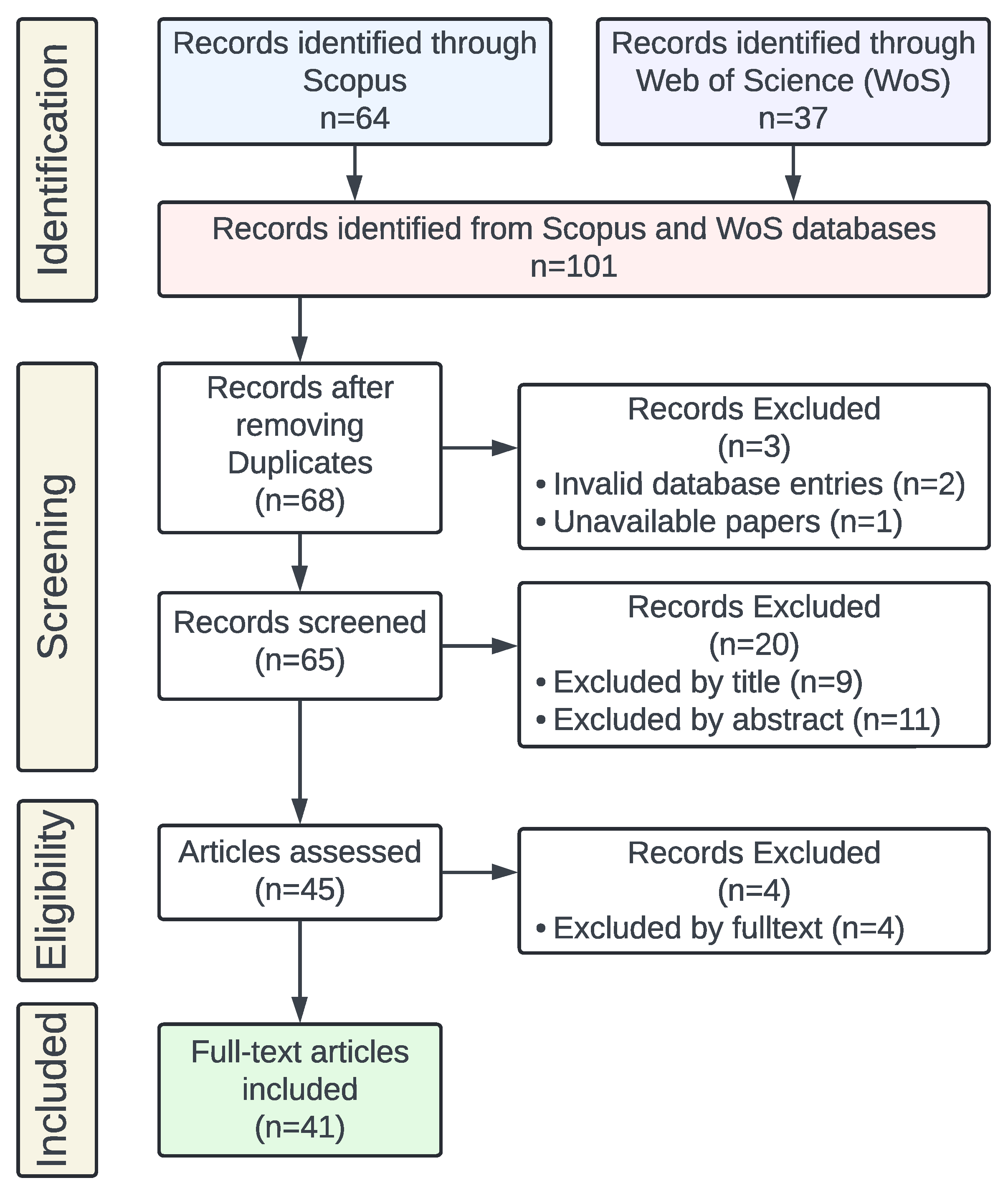
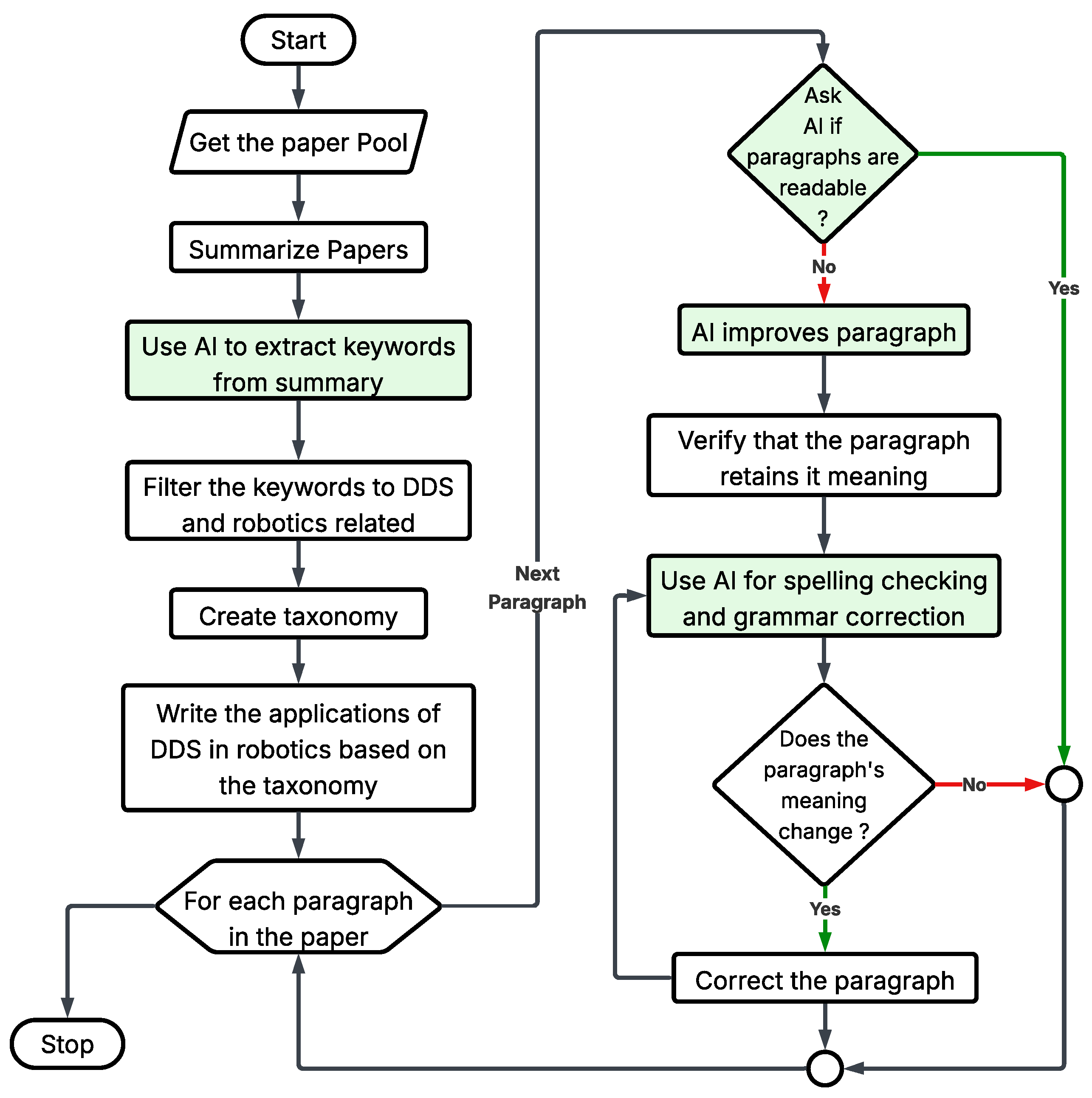
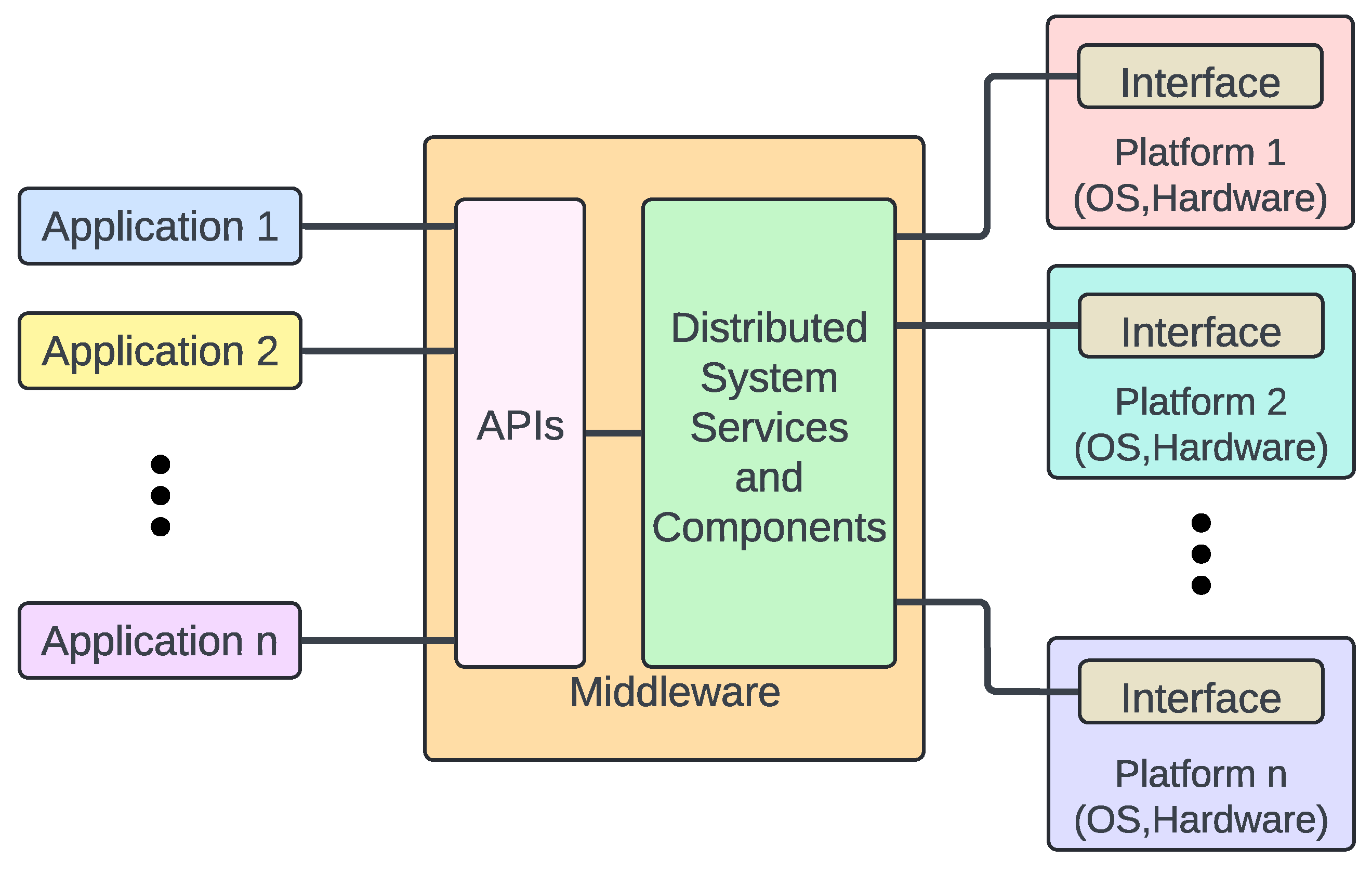
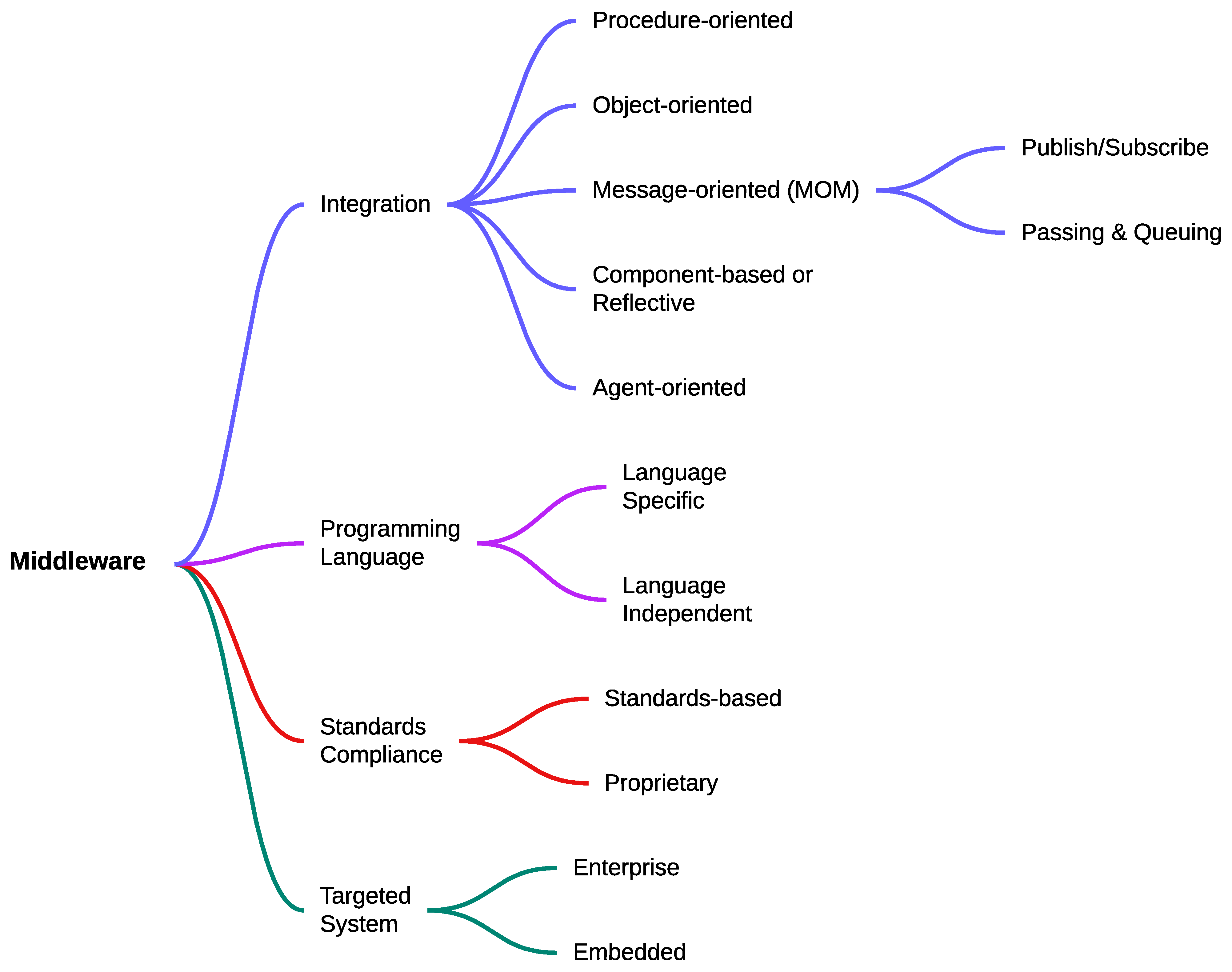
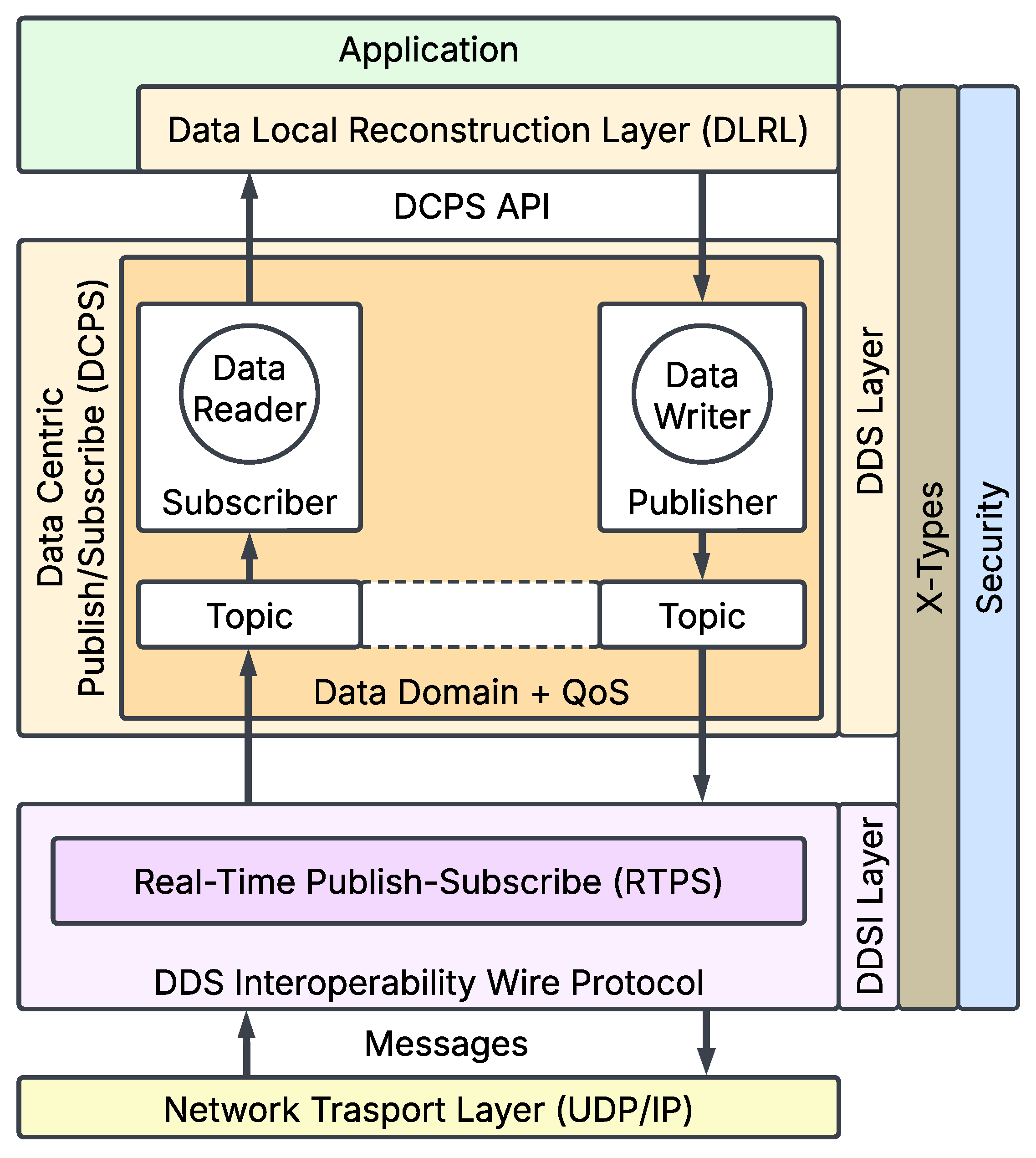
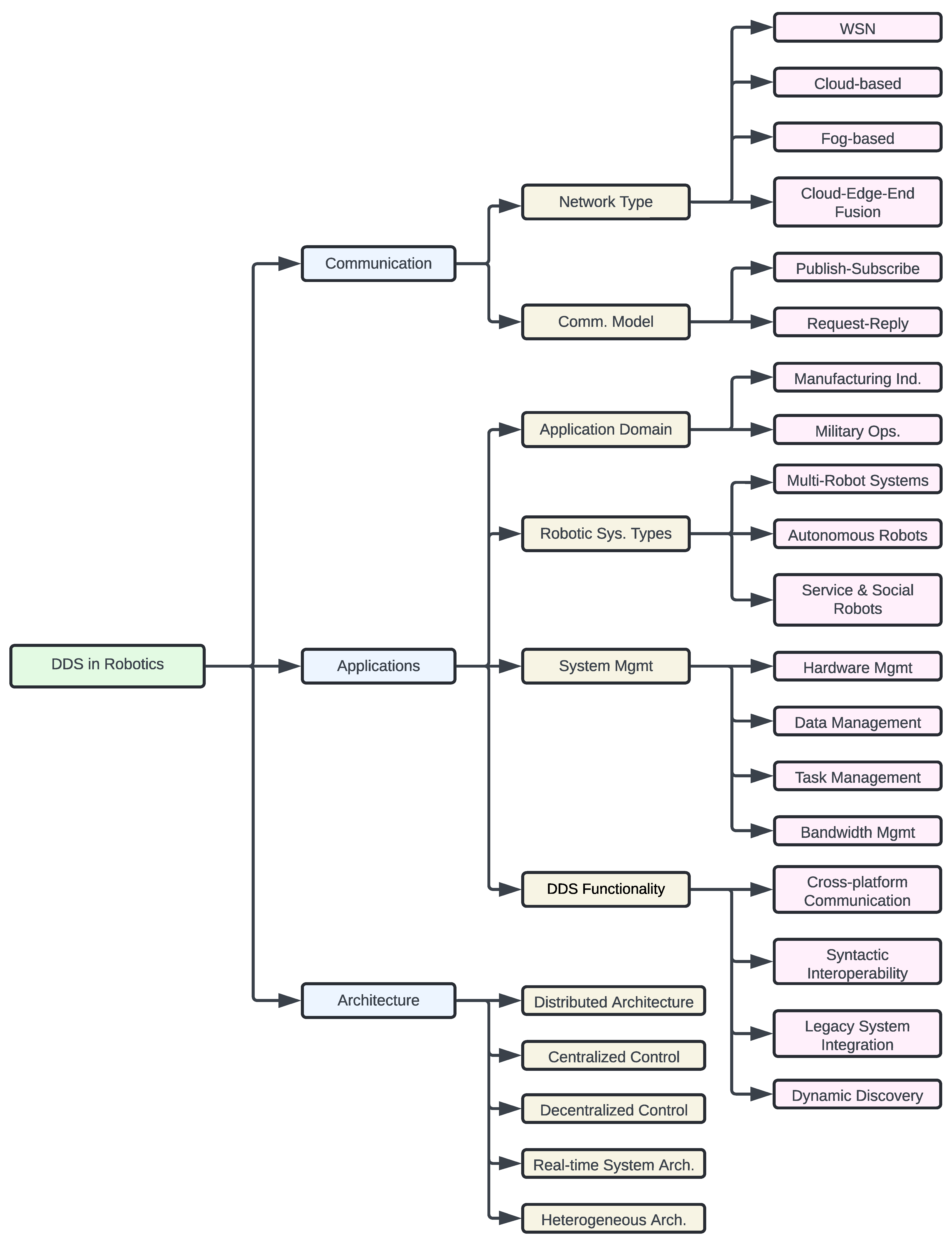
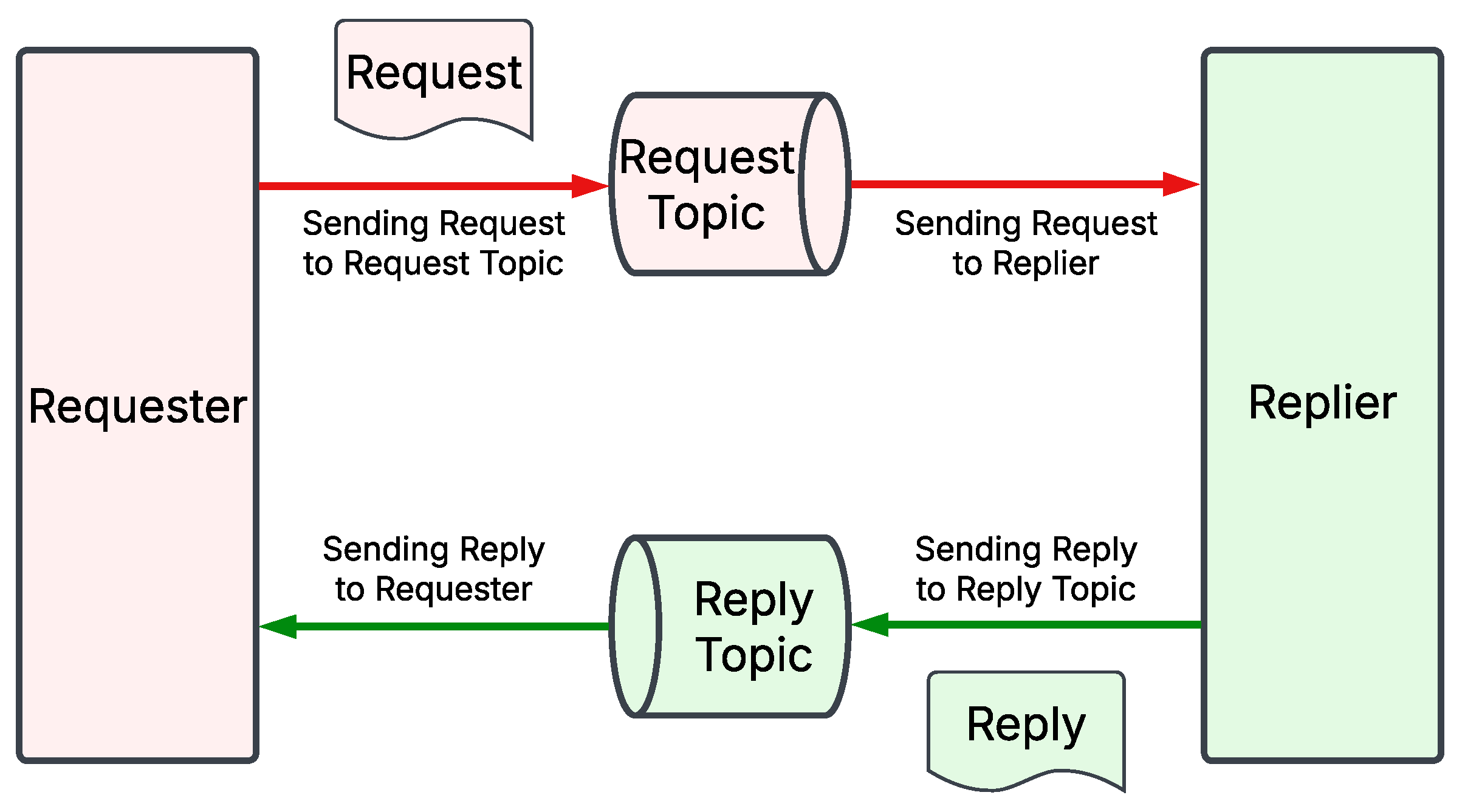


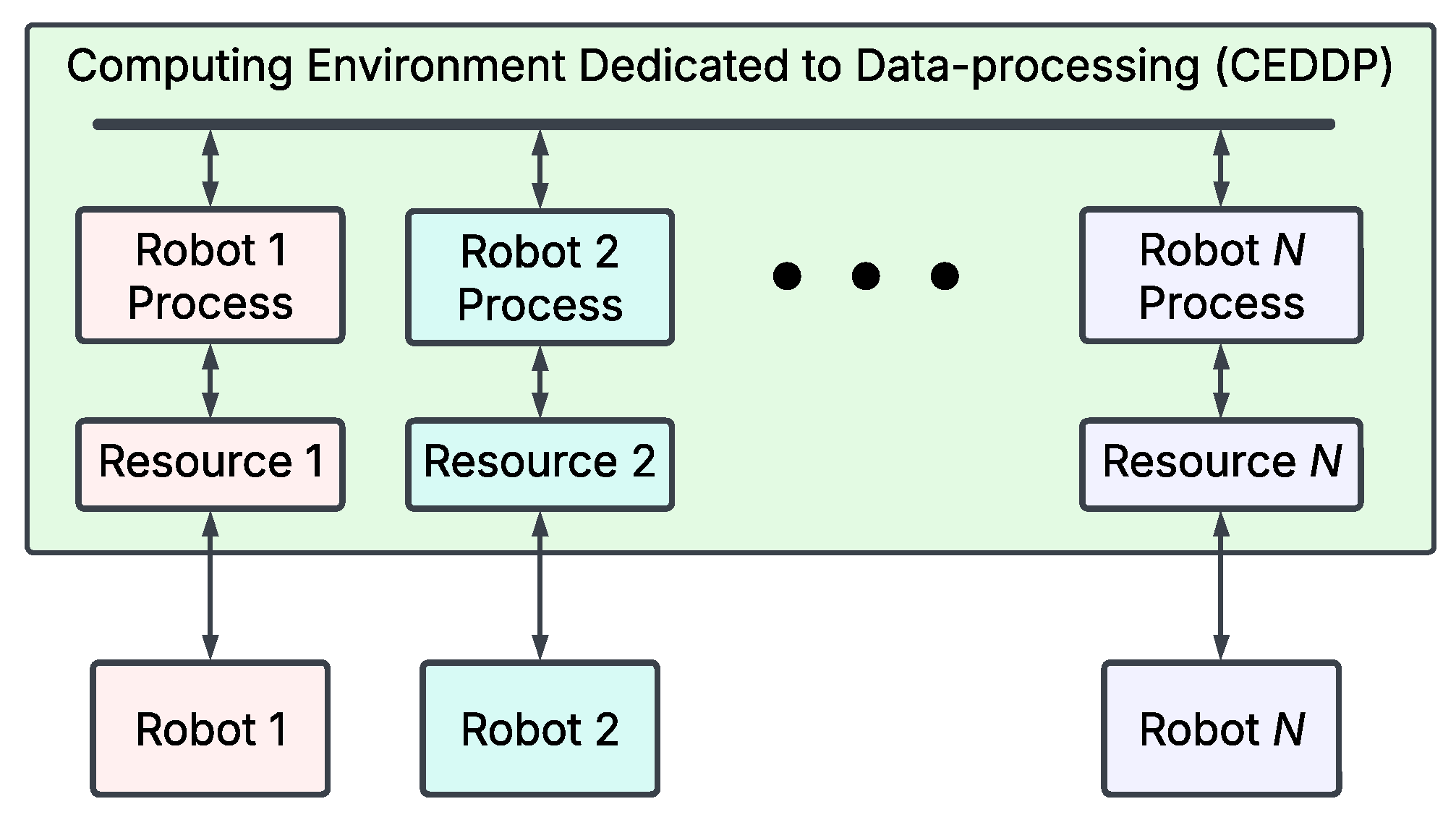
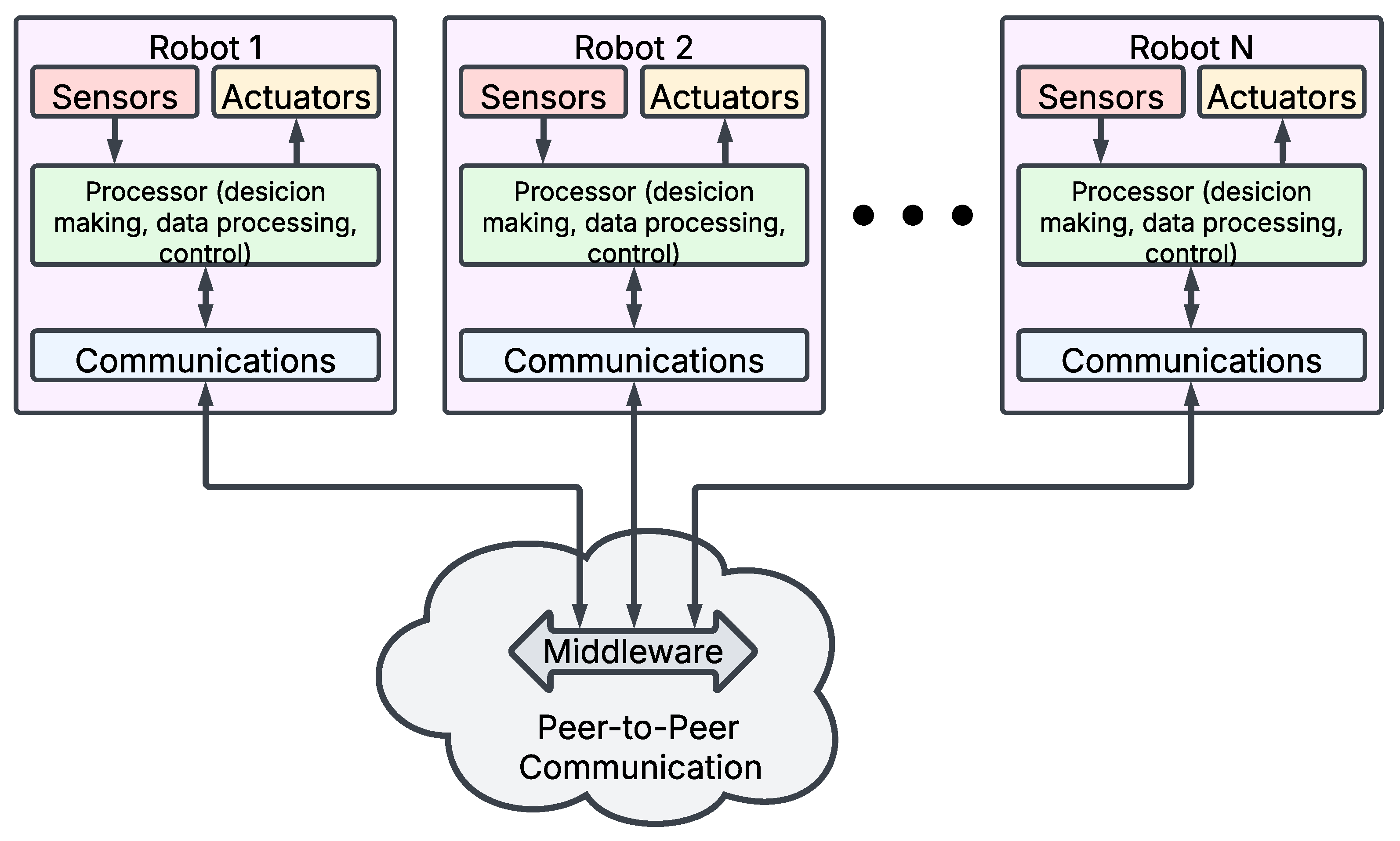
| Attribute | Description |
|---|---|
| Focus | The papers should focus on DDS-based middleware implementation in robotics, addressing specific application areas, associated challenges, or potential security and privacy concerns. |
| Type | We considered all scientific publications, including peer-reviewed articles, conference papers, and review papers. |
| Relevance | The papers must utilize DDS-based middleware as a communication channel in robotics applications. |
| Recency | We included all published papers from 2006 to 2024 to capture historical developments and emerging trends. |
| Attribute | Description |
|---|---|
| Duplicates | We excluded articles with substantial content overlap to maintain diversity and originality in the review. |
| Sources | Exclude all non-peer-reviewed materials, such as websites, blogs, and opinion pieces, to ensure the academic integrity of the review paper. |
| Completeness | We eliminated publications that were either incomplete, not accessible, or invalid. |
| Language | We excluded all papers published in languages other than English. |
| Ref. | Middleware Name | Company/Organization | Free and Open Source | Version | Release Year |
|---|---|---|---|---|---|
| [37] | RTI Connext DDS | Real-Time Innovations (RTI) | No | 7.4.0 | Oct. 2024 |
| [38] | OpenDDS | Object Computing, Inc. (OCI) | Yes | 3.31.0 | Jan. 2025 |
| [23] | Fast DDS | eProsima | Yes | 3.2.0 | Mar. 2025 |
| [39] | CoreDX DDS | Twin Oaks Computing | No | 5.0.0 | 2020 |
| [40] | Vortex OpenSplice | ADLINK Technology | Yes | 6.9.0 | Mar. 2021 |
| [41] | GurumDDS | GurumNetworks | No | 3.2.0 | - |
| [42] | Cyclone DDS | Eclipse Foundation (via ZettaScale) | Yes | 0.10.5 | May. 2024 |
| Year | Milestone |
|---|---|
| 2004 | First release of DDS 1.0 by OMG. |
| 2006 | DDS 1.2 Standard established; early industrial adoption begins. |
| 2007 | RTI releases Connext DDS 4.0, enhancing scalability for industrial applications. |
| 2008–2010 | DDS gains traction in defense and aerospace for low-latency communication. Early adoption in IoT and smart grids begins. |
| 2009 | First distribution of ROS released: ROS Mango Tango. |
| 2010 | ROS 1 was released. |
| 2010 | ROS (Robot Operating System) starts using DDS concepts indirectly via middleware layers. |
| 2012 | OMG releases DDS v1.4, introducing improved QoS policies and dynamic discovery. |
| 2014 | DDS Security Specification development begins. ROS 2 announces DDS as its default middleware, boosting adoption in robotics. |
| 2015 | DDSI-RTPS 2.2 published, improving real-time interoperability. |
| 2016 | DDS adopted in autonomous vehicles for real-time communication. |
| 2017 | Introduction of ROS 2, officially adopting DDS as default middleware. |
| 2018 | DDS Security v1.1 finalized, introducing authentication, encryption, and access control mechanisms. ROS 2 “Ardent Apalone” release integrates DDS, replacing ROS 1’s centralized architecture. Major DDS vendors (RTI Connext, Fast DDS, OpenDDS) expand support for IoT and autonomous systems. |
| 2019 | Eclipse Cyclone DDS emerges as the default middleware for ROS 2 and becomes widely adopted in robotics. |
| 2020 | X-Types v1.3 (dynamic data models) was released, enhancing flexibility in DDS communication. DDS adoption expanded in autonomous vehicles, drones, smart grids, and cloud–edge–end fusion architectures for industrial robotics. |
| 2021 | DDS Security applied to UAV swarms and military robotics to prevent rogue node attacks. |
| 2023 | FogROS2-SGC leverages DDS for secure global connectivity in distributed robotics. |
| 2023 | Studies highlight latency-performance tradeoffs when enabling DDS security in real-time systems. |
| 2024 | Latest DDS versions (e.g., RTI Connext 7.4, Fast DDS 3.2) enable ultra-low latency and enhanced interoperability, supporting AI/ML pipelines for distributed robotic training and real-time inference. |
| Publisher | ||||
|---|---|---|---|---|
| Fast DDS | Cyclone DDS | RTI Connext | ||
| Fast DDS | ✔  | ✔  | ✔  | |
| Subscriber | Cyclone DDS | ✔  | ✔  | ✔  |
| RTI Connext | ✔  | ✔  | ✔  | |
| ✔ Compatible Without Security | ||||
 Compatible With Security Compatible With Security | ||||
 Incompatible With Security Incompatible With Security | ||||
| Feature | Centralized System | Distributed System | Decentralized System |
|---|---|---|---|
| Control | Centralized decision making. | Shared control. | Fully autonomous operation. |
| Scalability | Low | Moderate to High | High |
| Fault Tolerance | Low | Moderate | High |
| Comm. Overhead | High | Moderate | Low |
| Decision Making | Fast | Faster | Fastest |
| Role of DDS | Facilitates centralized data distribution. | Enables distributed real-time communication. | Provides dynamic discovery and peer-to-peer communication. |
| References | Middleware/Architecture | Count |
|---|---|---|
| [68,72,74,86,89,94,97,102,113,115,117,118] | DDS Middlewar + ROS | 12 |
| [61,70,116,119] | DDS | 4 |
| [103,120] | Nerve Middleware | 2 |
| [69,95] | Micro-ROS (DDS for Microcontrollers) | 2 |
| [58,121] | Callback-group-level Executor (Real-Time ROS2) | 2 |
| [110,122] | Secure ROS2 (SROS2 Security Layer) | 2 |
| [85] | fpgaDDS | 1 |
| [96] | ARP-ROS + CCA | 1 |
| [92] | RTI DDS | 1 |
| [123] | Dynamic DDS Binding | 1 |
| [36] | Fast DDS (Custom Lightweight use) | 1 |
| [78] | FogROS2 | 1 |
| [79] | FogROS2-SGC | 1 |
| [87] | embeddedRTPS | 1 |
| [98] | Kafka-ROS Bridge | 1 |
| [105] | Robotics Middleware Framework (RMF) | 1 |
| [88] | FSACtrl Architecture | 1 |
| [55] | Dynamic-DDS-RPC (Service Integration) | 1 |
| [124] | Context-Aware DDS for Aerospace Assembly | 1 |
| [90] | Simulated Interactive Robotics Initiative (SIRI) | 1 |
| [77] | Adaptive AUTOSAR DDS Communication | 1 |
| [109] | Synchronization Middleware for Co-simulation | 1 |
| [83] | Time-Sensitive Attribute Scheduler (ROS2-RTPS) | 1 |
| Total | 41 |
Disclaimer/Publisher’s Note: The statements, opinions and data contained in all publications are solely those of the individual author(s) and contributor(s) and not of MDPI and/or the editor(s). MDPI and/or the editor(s) disclaim responsibility for any injury to people or property resulting from any ideas, methods, instructions or products referred to in the content. |
© 2025 by the authors. Licensee MDPI, Basel, Switzerland. This article is an open access article distributed under the terms and conditions of the Creative Commons Attribution (CC BY) license (https://creativecommons.org/licenses/by/4.0/).
Share and Cite
Gambo, M.L.; Danasabe, A.; Almadani, B.; Aliyu, F.; Aliyu, A.; Al-Nahari, E. A Systematic Literature Review of DDS Middleware in Robotic Systems. Robotics 2025, 14, 63. https://doi.org/10.3390/robotics14050063
Gambo ML, Danasabe A, Almadani B, Aliyu F, Aliyu A, Al-Nahari E. A Systematic Literature Review of DDS Middleware in Robotic Systems. Robotics. 2025; 14(5):63. https://doi.org/10.3390/robotics14050063
Chicago/Turabian StyleGambo, Muhammad Liman, Abubakar Danasabe, Basem Almadani, Farouq Aliyu, Abdulrahman Aliyu, and Esam Al-Nahari. 2025. "A Systematic Literature Review of DDS Middleware in Robotic Systems" Robotics 14, no. 5: 63. https://doi.org/10.3390/robotics14050063
APA StyleGambo, M. L., Danasabe, A., Almadani, B., Aliyu, F., Aliyu, A., & Al-Nahari, E. (2025). A Systematic Literature Review of DDS Middleware in Robotic Systems. Robotics, 14(5), 63. https://doi.org/10.3390/robotics14050063






